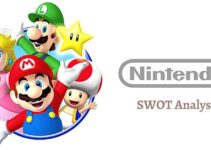Chevron is an oil, gas, and energy American multinational corporation. The oil and gas company started its business in 1879 under the name of Pacific Coast Oil. Today, we’ll discuss the SWOT analysis of Chevron; it outlines strengths and weaknesses; opportunities, and threats that the company has to face; as a business strategy analysis example company.
Products and services portfolio of Chevron
- Petrochemicals
- Oil
- Gas
- Energy
- Gasoline
Subsidiary Brands of Chevron
- Techron
- Havoline
- Caltex
- Texaco
- Chevron
Statistical facts and figures of Chevron
- Annual Revenue: 200.9billion USD (2023)
- Income: 21.37billion USD (2023)
- Employees: 45,600
- Asset net worth: 261.6Billion USD (2023)
Competitors of Chevron
- Clayton William Energy
- EOG Resources
- XTO Energy
- Valero Energy Corp
- BP
- Exxon Mobil
- Eni SPA
- Equinor
- Conoco Phillips
- Total Energies
- Royal Dutch Shell
The SWOT analysis of Chevron would analyze the internal strengths and weaknesses of the company; and external opportunities and threats that the brand has to face. Here’s Chevron SWOT analysis as a business strategy analysis example company as follows;
Strengths of Chevron
Some of the main internal strengths in the Chevron SWOT analysis example company as business strategy analysis are as follows;
Large Network
Chevron has established a very large network. According to an estimate, Chevron is operating its business in over 180 countries across the globe. The worldwide network of oil and gas business helps the company to approach various segments of the global customer market.
Lubricant Sponsorship
Chevron is the official sponsor of providing oil and lubricants to automobile racing tournaments and the world’s racing cars. Along with sponsorships of mega sporting events, the brand’s lubricants are highly recommended for the automotive vehicles of Mitsubishi, Nissan, Renault, and others.
Strong Financials
Chevron has a strong financial position comprising assets having a net worth of over 261.6 billion USD. The strong finances help the company to smoothly perform its various operations and handle any type of market fluctuations and financial disruptions.
Research & Development
Chevron invests a significant amount of capital resources in research for the development of advanced technological tools and equipment. It allows the company to decrease its carbon footprint and extract more oil with limited resources.
Brand Portfolio
Chevron has a very large business portfolio comprising various subsidiary brands. The oil and gas company is offering its petrochemical services under various brand names in different markets. It helps the company to diversify its business and brand portfolio and stabilize its earnings and resources.
Weaknesses of Chevron
Some of the main internal weaknesses in the Chevron SWOT analysis example company as business strategy analysis are as follows;
Negative Environmental Impact
Chevron’s petrochemical products and offerings have a negative impact on the environment by increasing the carbon footprint. On the other hand, the consumer market has become highly cautious about environmental sustainability; they’re saying no to traditional oil and gas products and businesses.
Higher Debt
Chevron has a higher debt in the profit and loss statement and the balance sheet. The higher debt-to-equity ratio is negatively impacting the growth rate and sales of the company.
Opportunities for Chevron
Some of the main available opportunities in the Chevron SWOT analysis example company as business strategy analysis are as follows;
Market Expansion
Chevron should expand its business into new regions, markets, and countries across the world. The global market holds great potential for the sale of oil, gas, lubricants, and energy businesses. It would help the company to increase its market share, revenue, and network.
Portfolio Expansion
Along with market expansion, Chevron should also expand its product and service portfolio by launching new products. They are like oil, gas, lubricant, premium, and economy class oil and gas; it would help the company to target new segments of the customer market.
Renewable Energy
Chevron should shift its focus towards the development of renewable energy. It allows the company to keep up with the growing market trends by developing and launching efficient and environmentally sustainable products and services.
Threats to Chevron
Some of the main potential threats in the Chevron SWOT analysis example company as business strategy analysis are as follows;
Tough Competition
Chevron is facing tough competition from other competitive brands like Shell, Total, and Equinor. They all have established a strong brand name and a very loyal database of customers; their market presence is negatively impacting the company’s revenue, growth, and profitability.
Regulatory Requirements
Government regulations have become very strict in recent years for oil and gas companies to decrease the carbon emission rate. The objective is to decrease the carbon footprint on the environment; Chevron should comply with the environmental sustainability initiatives and requirements.
Conclusion: Chevron SWOT Analysis Example Company |SWOT Analysis of Chevron |Business Strategy Analysis
After an in-depth study of the swot analysis of Chevron; we have realized that Chevron is the world’s leading oil and gas multinational company. If you are learning about Chevron SWOT analysis example company; then you should keep in mind the abovementioned internal strengths and weaknesses; external opportunities and threats as brand strategy analysis.

Ahsan Ali Shaw is an accomplished Business Writer, Analyst, and Public Speaker. Other than that, he’s a fun loving person.


